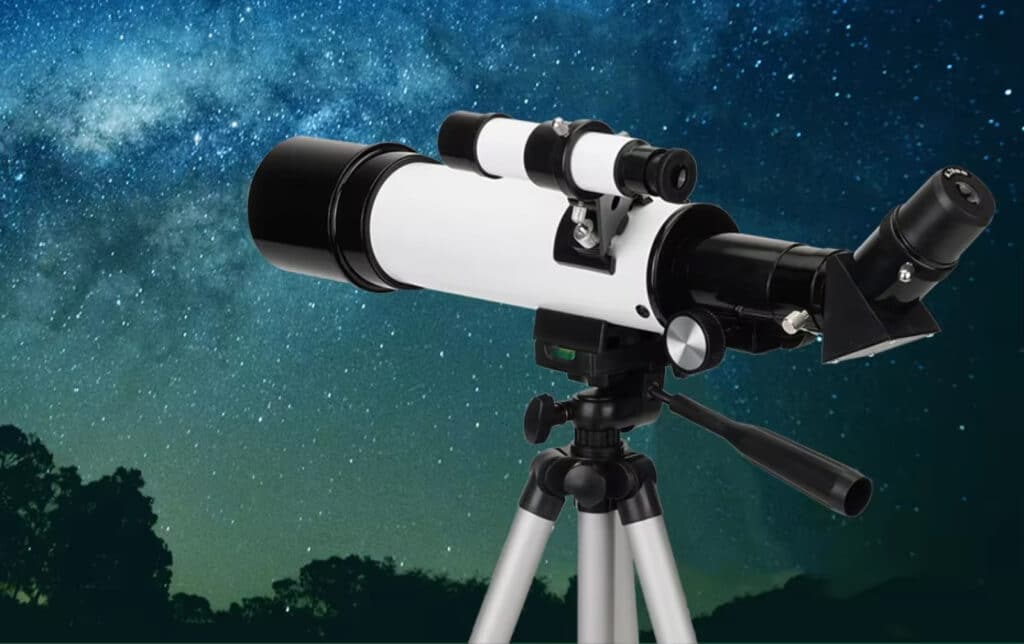
Have you ever looked up at the night sky and felt a sense of wonder? The twinkling stars, mysterious planets, and distant galaxies hold secrets waiting to be discovered. But without the right equipment, these cosmic wonders remain just tiny dots of light.
Choosing your first telescope for beginners can be overwhelming. 🔭 With hundreds of models, technical specifications, and price points, many new astronomers end up with equipment that’s either too complicated or doesn’t perform well. Imagine spending your hard-earned money on a telescope that shows blurry images, is impossible to set up, or breaks after a few uses.
The good news is that today’s market offers excellent telescopes for beginners that combine quality optics, user-friendly design, and reasonable prices. 🌟 These entry-level instruments can reveal incredible details of the moon’s craters, Saturn’s rings, and distant star clusters without requiring a degree in astrophysics to operate.
In this guide, we’ll explore the five best telescopes for beginners that offer the perfect balance of performance, ease of use, and value. Whether you’re buying for yourself or as a gift, these recommendations will help you avoid common pitfalls and start your astronomical journey with confidence. ✨

Noah Bishop is an astrophysicist and dedicated astronomy educator with over 15 years of experience reviewing telescope technology. His passion for making astronomy accessible to everyone drives his straightforward, practical approach to telescope evaluation.
from SUBony
SUBony delivers an exceptional entry-level telescope that makes stargazing accessible to everyone. This 60mm refractor telescope combines quality optics with user-friendly design, perfect for aspiring astronomers taking their first steps into the cosmos. The complete package includes everything needed to begin your astronomical journey immediately. 🔭
The 1.25″ 45° correct image prism is a standout feature that enhances the viewing experience considerably. Unlike many beginner telescopes that produce inverted images, this orthographic mirror delivers properly oriented views that match what you’d see with your naked eye. This makes the telescope equally valuable for both celestial observation and daytime terrestrial viewing like birdwatching or scenery appreciation.
Precision engineering is evident in the metal focusing mount which provides smooth, accurate adjustments when honing in on distant objects. This metal interface ensures higher accuracy than plastic alternatives, guaranteeing proper alignment of the optical axis for crisp, clear images. The brass ring clamp with two locking screws securely holds accessories without damaging them, a thoughtful design feature often missing from entry-level models. ✨
The included accessories transform this telescope from a simple device into a complete observation system. The K20mm eyepiece provides medium magnification perfect for general viewing, while the 5x24mm finder scope makes locating celestial objects significantly easier. The multi-coated glass enhances light transmission for brighter, more detailed images of moon craters, planets, and star clusters. The lightweight aluminum tripod balances portability with stability, making it easy for both adults and children to transport and set up. 🌟
When researching the best telescope for beginners, the SUBony 60mm Refractor consistently stands out for its combination of quality optics, thoughtful design, and complete accessory package. The 400mm focal length provides good magnification while maintaining a wide enough field of view to make locating objects manageable for newcomers. For anyone looking to explore the night sky without overwhelming complexity or expense, this telescope represents an ideal starting point.
The SUBony 60mm Refractor Telescope represents exceptional value for anyone beginning their astronomical journey. Its combination of quality optics, user-friendly design, and comprehensive accessory package eliminates common barriers to entry in astronomy. With free shipping on all orders and 24/7 customer support available to answer any questions, SUBony ensures a smooth experience from purchase to first observation. EXPLORE NOW!
from Koolpte
Koolpte Smart Telescope represents the next generation of optical instruments designed specifically for the digital age. This innovative telescope combines traditional optics with modern smartphone connectivity, creating a bridge between classic astronomy and contemporary technology. The integrated smartphone adapter allows users to capture, share, and even livestream their celestial discoveries with friends and family.
The telescope features a high-quality 70mm aperture that gathers sufficient light for detailed observations of the moon’s surface, planetary features, and brighter deep-sky objects. This aperture size strikes an excellent balance between light-gathering capability and portability, making it suitable for both backyard stargazing and trips to darker sky locations. The multi-coated optics ensure maximum light transmission for brighter, more contrast-rich images.
For telescope beginners, the Koolpte model eliminates many common frustrations through its intuitive design and smartphone integration. The accompanying app provides guided tours of the night sky, helping users locate interesting objects without the steep learning curve typically associated with astronomy. The smooth focusing mechanism allows for quick adjustments, while the stable altazimuth mount provides smooth movement for tracking celestial objects as they move across the sky.
The complete package includes multiple eyepieces for different magnification levels, a Barlow lens to increase viewing power, and the essential smartphone adapter for photography and sharing. The telescope assembles in minutes without tools, and the included instruction manual provides clear guidance for those new to astronomy. The entire setup weighs under 10 pounds, making it manageable for users of all ages and experience levels.
from Dianfan
Dianfan Astronomical Reflector Telescope offers impressive light-gathering abilities in a package designed with beginners in mind. This 114mm aperture reflector telescope collects significantly more light than smaller refractor models, revealing details in deep sky objects that would otherwise remain invisible. The relatively short 675mm focal length provides a wider field of view that makes finding celestial targets easier for newcomers to astronomy.
The sturdy equatorial mount represents a step up from basic altazimuth designs, allowing users to track objects across the night sky by adjusting a single axis. This feature becomes increasingly valuable during longer observation sessions and provides an excellent introduction to more advanced astronomical techniques. The mount includes slow-motion control cables for making precise adjustments when centering and following celestial objects.
For those seeking a telescope for beginners that offers room to grow, the Dianfan includes three eyepieces (25mm, 10mm, and 6mm) providing low, medium, and high magnification options. The included 3x Barlow lens effectively triples the magnification of each eyepiece, creating a versatile range of viewing options. The multi-coated optics enhance contrast and image brightness, particularly important when observing faint nebulae and distant galaxies.
Assembly requires approximately 30 minutes following the detailed instruction manual, and no specialized tools are needed. The complete package includes a smartphone adapter that allows for basic astrophotography, capturing and sharing your astronomical discoveries. The aluminum tripod provides good stability while remaining lightweight enough for transport to darker observation sites. For beginners looking to explore beyond the basics, this reflector telescope offers an excellent balance of capability, quality, and value.
from Celestron
Celestron NexStar 8SE Telescope represents the premium end of instruments suitable for dedicated beginners and intermediate astronomers. This Schmidt-Cassegrain design combines an impressive 8-inch aperture with a folded optical path, resulting in exceptional light-gathering ability in a relatively compact package. For enthusiastic beginners willing to invest in quality equipment, this telescope delivers views of planets, deep sky objects, and galaxies that approach what you would see at many public observatories.
The defining feature of this telescope is its computerized GoTo mount with a database of over 40,000 celestial objects. After a simple alignment process, the telescope can automatically locate and track planets, stars, galaxies, and nebulae with remarkable precision. This technology significantly flattens the learning curve for beginners, allowing them to observe interesting objects immediately rather than spending hours learning to navigate the night sky manually.
Despite its advanced capabilities, the NexStar 8SE qualifies as a telescope for beginners because of its user-friendly setup and operation. The single fork arm altazimuth mount assembles without tools and the SkyAlign technology requires only pointing the telescope at three bright objects for full alignment. The included hand controller features a backlit display and intuitive menu system that guides users through the process of selecting and viewing targets.
from MEEZAA
MEEZAA Smart Telescope represents the intersection of traditional astronomy and modern digital technology. This innovative instrument combines quality optical components with smartphone connectivity and app integration to create an accessible entry point for tech-savvy beginners. The 80mm aperture provides sufficient light-gathering capability for detailed lunar observation, planetary viewing, and brighter deep sky objects.
The most distinctive feature of this telescope is its full digital integration through a dedicated smartphone app. After connecting via WiFi, users can control the telescope remotely, access guided tours of the night sky, and automatically locate interesting celestial objects without memorizing star charts or coordinates. The app includes educational content about various astronomical objects, making this as much a learning tool as an observational instrument.
For the modern telescope beginner, the MEEZAA offers significant advantages over traditional designs. The built-in camera and smartphone interface allow for immediate image capture, recording, and sharing with friends and family. This social aspect of astronomy can increase engagement and interest, particularly for younger users. The motorized GoTo mount eliminates the challenge of manually finding objects, allowing beginners to spend more time observing and less time searching.
A smart telescope represents the evolution of traditional astronomical instruments through the integration of computer technology, automated tracking systems, and digital imaging capabilities. These modern devices combine high-quality optics with computerized mounts that can automatically locate and track celestial objects, eliminating the learning curve associated with star maps and manual telescope operation. Many smart telescopes incorporate smartphone connectivity, allowing users to control the telescope, view images, and even capture astrophotography directly from their mobile devices. This technological integration makes astronomy accessible to beginners while offering convenience features that even experienced stargazers appreciate.
Smart telescopes are designed for astronomy enthusiasts at all levels who value convenience, accessibility, and enhanced viewing experiences. They’re particularly suited for beginners who might be intimidated by traditional manual telescopes but are comfortable with digital interfaces and mobile apps. Families appreciate the shared viewing experiences made possible through screen sharing features. Urban astronomers benefit from the digital enhancement capabilities that can overcome some limitations of light pollution. Amateur astrophotographers gain access to simplified imaging systems that deliver impressive results without requiring extensive technical knowledge or additional equipment.
The diameter of the main optical element determines how much light the telescope gathers. Larger apertures show more detail but cost more and reduce portability.
A stable mount prevents frustrating image vibrations. Even the best optics perform poorly on an unstable mount, so prioritize stability over additional accessories.
Look for telescopes that include essential accessories like multiple eyepieces, finder scope, and moon filter to avoid immediate additional purchases.
Beginners benefit from telescopes that assemble in 15-30 minutes without special tools. Complicated setup can discourage regular use.
Quality instruction manuals, star charts, and companion apps enhance the learning experience and help users navigate the night sky.
Beware of telescopes advertising extremely high magnifications (over 300x) on small apertures. These create dim, blurry images that disappoint new users.
Unstable mounts and tripods cause frustrating vibrations that make observation nearly impossible. Avoid telescopes with undersized or purely decorative tripods.
Mass-market telescopes sold as toys typically feature poor optics and flimsy construction. These “hobby killers” often end up unused in closets.

Noah Bishop is an astrophysicist and dedicated astronomy educator with over 15 years of experience reviewing telescope technology. His passion for making astronomy accessible to everyone drives his straightforward, practical approach to telescope evaluation.

© All Rights Reserved! Best Buy Pick 2025